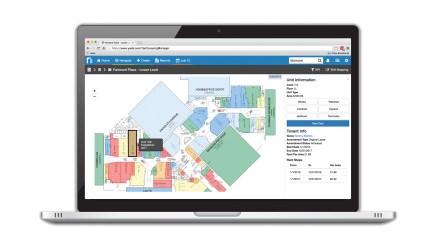Leasing agents often have to be part lawyer, part CPA and part tour guide when handling such details as monitoring existing tenant lease options, notifications and expiration dates, tracking prospective tenants, crafting letters of intent and arranging showings. Customer relationship management technology that manages these operations has come a long way over the past few years. A key development was stacking plans and floor plans that provide a two-dimensional visual representation of a building showing space availability, tenants on each floor, expiration dates and current rental rates. Color coding helps managers, leasing teams and others identify opportunities and expose risk. And mobile technology has taken lease execution out of the office and into the field, further shortening the leasing cycle. What’s the next step for CRM technology? The Balance Sheet asked Tom Dragmen, Yardi’s manager of global solutions, for a deeper dive into the emerging generation of stacking plan and floor plan technology. Q: What does “interactive stacking and floor plans” mean? A: This refers to a rich visual representation of lease expirations and related space details. They can overlay configurable performance measures and metrics on floor plans. They also provide a visual dimension for efficiently analyzing expirations, options, unit types and rent-per-area trends in buildings. Q: What’s the user perspective? A: Leasing agents and others get a full graphical display of vital information including lease statistics that determine rental rate trends. They can see stacking and floor plans based on expirations occurring in specific years, rents per area, encumbrances, options, proposals, unit types, and tenant performance measures such as sales per area, sales variances year over year and foot traffic. Q: How can this information be used? A: When integrated with CRM and accounting systems, the new generation of interactive stacking and floor...
Better Leasing with Yardi
Pyramid Management Group
In the fast-paced world of retail leasing, preparation for a client presentation is paramount. Managing the slide decks, floor plans, lease documents and other materials that make a lease pitch possible is no small feat. At Yardi client Pyramid Management Group, a commercial property manager handling 16 major indoor shopping malls in New York and Massachusetts, John Cico sought out a document management solution that would relieve the headaches experienced in the past. “Emails within Outlook were really not accessible by other people or organized in such a way that made it possible for us to go back and have another leasing rep pick up the trail from where it left off,” explained Cico, a Director in the company’s Finance department. But a centralized, cloud-based repository for documents wasn’t the only item on the wish list. He wanted a technology solution that would make his team of 35 leasing representatives and mall managers stand out in the retail leasing space. In a perfect world, it would support mobile on-site presentations to clients, electronically execute leases, and archive important documents for reference and reuse. As he explained Pyramid’s needs to the Yardi Commercial LeasingPad development team, Cico was impressed with their response. “It’s quite pleasing to see the amount of effort and time that Yardi will put into developing something that will truly work for us. From the start, and continuing today, Yardi has always been willing to listen and when things could be changed to accommodate our needs, they’ve always met that challenge,” Cico said. Knowing that a brand-new platform for document retention and process management wouldn’t be easily implemented overnight, Pyramid Management Group wisely implemented Yardi’s Commercial LeasingPad and Orion Document Management applications in stages. The intent was to not distract from signing leases as usual but rather, to focus on the efficiencies made possible with the new technology. “The real desire was not to impose such a huge learning curve on people initially that it would take the focus away from the leasing effort. We couldn’t slow down the production of our leasing reps, such that leasing for the next six months could be hindered. The idea was that we would try to phase the process in over a number of steps, to minimize the disruption of the leasing process,” Cico explained. No ill effects on performance have been noted thus far. In 2015, Pyramid Management Group has had a stellar year, matching their corporate performance from 2014 within the first nine months of the year. With leasing volume and occupancy high, it’s a good time to explore further opportunities to enhance the leasing process and keep improving production, Cico noted. The hurdle of individual skepticism about a new system, common in most real estate technology implementations, was effectively overcome by taking a gradual approach. Now 18 months into the process, “we are seeing our leasing agents become more comfortable with it. I think they understand some of the mistakes that they were making early on, and we have been able to correct those,” Cico said. Adoption of the platform is 100 percent. And he isn’t done making changes yet, either. Each morning at 6:30am, the Pyramid Management Group team gathers for an all-hands-on-deck meeting to discuss pending transactions and leasing progress. It’s a veritable war room of leasing strategy. Management of documents is key to its success, as team members present upcoming client pitches and trade ideas and feedback. In conjunction with LeasingPad, Orion Document Management has created quick and easy access to the presentation materials required. Ultimately, Cico envisions, the morning meeting will be even further dependent on Yardi technology. A digital, 3-D stacking plan customized for the company by Yardi has been a major first step. Moving walls and retail spaces within the mall is an important part of the leasing process, and only so much information can be presented on a 2-D, traditional...


